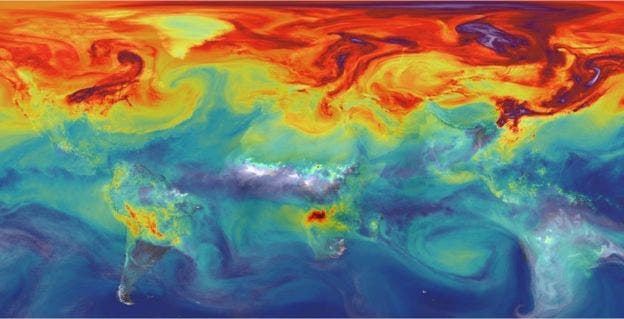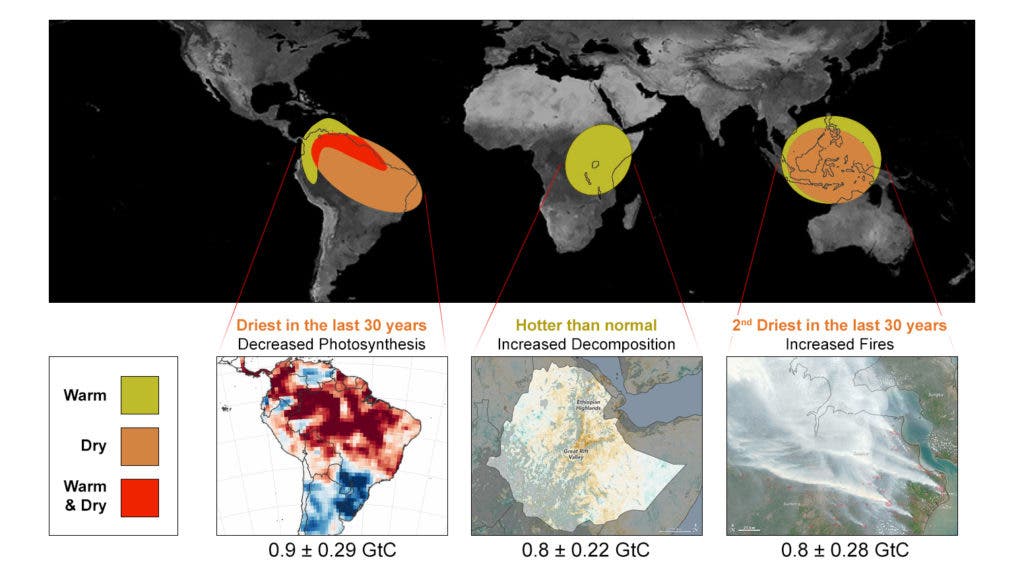NASA’s high-resolution satellites are offering us a unique view of what’s happening with carbon dioxide on Earth
Aside from looking up towards the stars, NASA’s eyes are also glancing down on Earth. From its vantage point, the Orbiting Carbon Observatory-2 (OCO) sees the subtle strings that link CO2 to everything on the planet. The ocean, all the land, the atmosphere, all ecosystems and creatures and last but certainly not least — mankind. A special collection of five research papers document how CO2 is intertwined with all aspects of life on Earth.
Every year, mankind emits a whopping 40 billion tons of CO2. Most of that, the data shows, comes from cities. More than 70 percent of carbon dioxide emissions from human activities originate in urban areas, but it’s hard to see just what happens to the CO2 because it merges with the atmosphere right after it’s emitted. In order to better understand these processes, Florian Schwandner of JPL and colleagues used OCO-2 data to study changes in the CO2 within the air column below the satellite. For instance, within the city of Los Angeles, researchers were able to isolate some individual sources of CO2 and then track the carbon as it moved from the urban center to the suburbs and then towards the outskirts of the city.
OCO-2’s orbit also enabled scientists to monitor CO2 emissions from some volcanoes — which contrary to popular belief, are very small compared to mankind’s contribution. Atmospheric carbon dioxide acts as Earth’s thermostat, and we’re the ones supercharging it — not nature.
Carbon-monitoring satellites are extremely useful as they allow us to get a broader and more accurate picture of what’s happening to the greenhouse gas within our atmosphere, but the problem is that they’re few and far between.
“They’re very precise, but there’s very few of them,” says Annmarie Eldering, an environmental engineer at NASA’s Jet Propulsion Laboratory. “If you want to understand how the continent of Africa or the Pacific Ocean relate to the global carbon cycle, that data set isn’t very sensitive.”

The second paper analyzed how the 2015-16 El Niño affected the carbon dioxide cycle over the Pacific. El Niño is a climate cycle in the Pacific Ocean with a global impact on weather patterns, typically associated with a large band of hotter water. The 2015-16 event was the hottest in human history, and it dramatically raised CO2 emissions over large areas of the globe. However, human emissions remained largely similar, so what gives?
Aside from carbon dioxide, OCO’s instruments also allowed it to observe solar-induced fluorescence, or SIF. The SIF is emitted by chlorophyll molecules in plants, indicating that photosynthesis is happening. This was the key to the extra CO2. In South America, the biggest drought in three decades limited the vegetation’s ability to consume CO2. In Africa, high temperatures helped decompose plant material, which also releases CO2; and in Asia, rampant fires released massive quantities of peat carbon which had accumulated over thousands of years.
“This is the gold star for OCO: we wanted to understand what happened in different regions of the world, Annmarie Eldering adds.

These observations are truly groundbreaking — the fact that they were all released at once makes it even more impressive. Talking to BBC, Paul Palmer, an atmospheric scientist at Edinburgh University in the UK, says that this type of satellites opens up an entirely new way of looking at our planet.
“This is the first major climate variation where we’ve had satellite observations of atmospheric composition, and of land properties and of ocean properties – all at the same time,” he said.
The last major El Niño was 1997/8 and that was really just the start of the satellite tropospheric chemistry missions. We’re now sampling a lot of different variables and the real breakthrough comes when you tie all the information together. We’re not quite there yet, but this is a really good start.”
The work also involved heavy use of complex modeling, and these results will help finesse future models even more.
“Understanding how the carbon cycle in these regions responded to El Nino will enable scientists to improve carbon cycle models, which should lead to improved predictions of how our planet may respond to similar conditions in the future,” said OCO-2 Deputy Project Scientist Annmarie Eldering of JPL. “The team’s findings imply that if future climate brings more or longer droughts, as the last El Nino did, more carbon dioxide may remain in the atmosphere, leading to a tendency to further warm Earth.”
However, the Trump administration has slashed the budget for such projects and has announced plans to do so even more in the future. In their attempt to promote fossil fuels, America’s leaders are taking away some of the most vital tools scientists are using to study the planet.
For more information on NASA’s Orbiting Carbon Observatory-2 mission, visit NASA’s OCO page.






